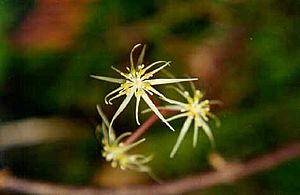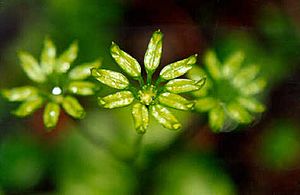Goldthread facts for kids
Quick facts for kids Goldthread |
|
|---|---|
 |
|
| Coptis occidentalis flowers | |
| Scientific classification |
|
| Kingdom: | Plantae |
| Clade: | Tracheophytes |
| Clade: | Angiosperms |
| Clade: | Eudicots |
| Order: | Ranunculales |
| Family: | Ranunculaceae |
| Subfamily: | Coptidoideae |
| Genus: | Coptis Salisb. |
| Species | |
|
See text |
|
Coptis is a genus (a group) of flowering plants, often called goldthread or canker root. There are about 10 to 15 different kinds of Coptis plants. They are part of the Ranunculaceae family, which includes plants like buttercups. You can find these plants growing naturally in parts of Asia and North America. They get their name "goldthread" because their roots are a bright yellow or gold color, like a thread!
Contents
Types of Goldthread Plants
There are several species of Coptis plants. Each one has its own special features and places where it grows. Here are some of the well-known types:
- Coptis aspleniifolia - This plant is also known as fernleaf goldthread.
- Coptis chinensis - Called Chinese goldthread, or Huang lian in Chinese.
- Coptis deltoidea
- Coptis trifolia (also known as Coptis groenlandica)
- Coptis japonica - Known as Japanese goldthread, or Riben huang lian in Chinese.
- Coptis laciniata - This type is called Oregon goldthread and grows in California, Oregon, and Washington State.
- Coptis occidentalis - Known as Idaho goldthread, found in Idaho, Montana, and Washington.
- Coptis omeiensis
- Coptis quinquefolia
- Coptis quinquesecta
- Coptis teeta - Called Yunnan goldthread, or Yunnan huang lian in Chinese.
- Coptis trifolia - This is the threeleaf goldthread, also known as savoyane or canker-root. It grows in Eastern Eurasia, Greenland, Canada, and the USA.
How Goldthread Plants Are Used
Some types of Coptis plants have been used for a long time in traditional medicine.
Medicinal Uses
One important species is Coptis teeta. People in China and the Eastern Himalayan regions of India (especially in the Mishmi Hills) use it as a medicinal herb. It's known as a "bitter tonic" because of its strong taste.
- It has been used to help with fevers, like those from malaria.
- It's also used to help with upset stomachs or problems with digestion.
- In traditional Chinese medicine, it's believed to help people who have trouble sleeping.
The roots of Coptis plants contain a special natural substance called alkaloids, specifically one called berberine. This is what gives the roots their bitter taste and some of their medicinal properties.
Protecting Coptis teeta
Unfortunately, Coptis teeta has become an endangered plant. This is because too many plants have been collected from the wild. Also, there are natural problems with how the plant reproduces, which makes it harder for new plants to grow. Scientists are working to understand and protect this important plant.
In Canada, dried Coptis roots (goldthread) were sold until the 1950s or early 1960s. People would steep them in water to make a "tea." This tea was then used to help with certain mouth infections.
Where Goldthread Plants Live
Coptis plants usually grow in forests where it's not too hot or too cold. They often live among oak trees and rhododendron bushes. Sometimes, you can even find them growing under thick bamboo plants.
Life Cycle and Habitat
In places like the Mishmi Hills in India, Coptis plants flower in early spring, usually in March or April. They produce their fruit and seeds in July or August. It's quite rare to see young Coptis seedlings. When they do sprout, they often grow on dead wood that is covered in moss on the forest floor. Sometimes, they even grow on mossy branches of rhododendron plants.
Scientists have found a new type of Coptis teeta called subsp. lohitensis. This subspecies looks different from the main Coptis teeta plant and grows in a different area, in broadleaf forests.
See also
 In Spanish: Coptis para niños
In Spanish: Coptis para niños


